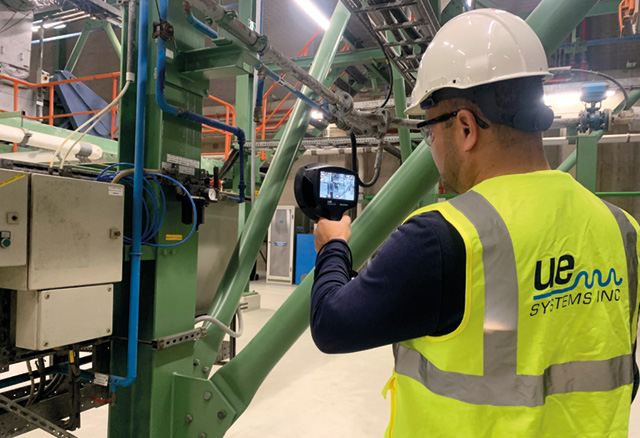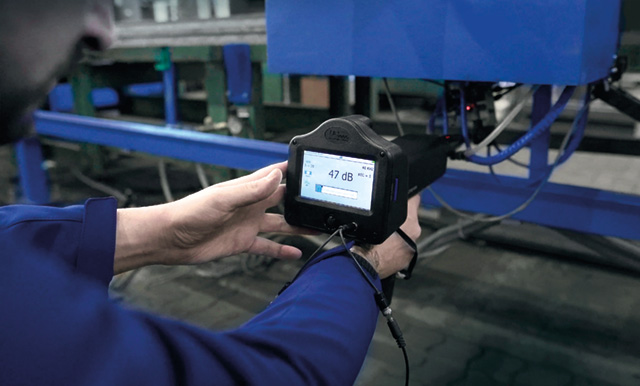
With energy prices at an all-time high, it is now more important than ever for maintenance teams to focus on detecting compressed air leaks at their industrial facilities, explains UE Systems Regional Manager UK & Ireland, Christopher Hallum.
Generating compressed air becomes more and more expensive as electricity prices continue to rise, making detecting and fixing leaks a greater priority.
It is estimated that more than 50% of all compressed air systems have energy efficiency problems, and losses from such systems can be very costly. About 30% of all industrial compressed air is lost due to leaks, generating a huge economical and energetic waste.
Just think that a leak of just 3mm can cost up to £574 per year if it is not detected (on a five bar pressure system). As a result, detecting and repairing compressed air leaks may lead to huge energy savings.
Leak detection methods
There are a few methods used to detect compressed air leaks. One of the most traditional methods, still widely used, is detecting leaks with a soap and water solution. This method has a few disadvantages: it takes a very long time, creates additional work and may also constitute a safety hazard.
A much more effective, quick and safe method is using ultrasonic inspections instruments. These can be listen-only instruments or the more recent ultrasound leak detection cameras, which make the job even easier.
Why use ultrasound for leak detection?
Using the characteristics of ultrasound, locating leaks is fast and easy, in the following ways:
• Directionality of sound waves makes locating the source easy;
• Intensity of signal: the closer you get, the more sound you detect;
• Fixed frequency makes it effective to locate even in a loud factory environment.

As any gas (air, oxygen, nitrogen, etc.) passes through a leak orifice, it generates a turbulent flow with detectable high frequency components.
By scanning the test area with an ultrasound instrument, a leak can be heard through the headset as a rushing sound or can be noted on the display/meter. The closer the instrument is to the leak, the louder the rushing sound and the higher the reading.
Should ambient noise be a problem, a rubber focusing probe may be used to narrow the instrument’s reception field and to shield it from conflicting ultrasounds.
In addition, frequency tuning (available in most models) dramatically reduces background noise interference to provide ease of ultrasonic leak detection as never before experienced.
Compressed Air Leak Surveys – evaluating the cost of leaks
One of the more popular applications for ultrasound is the creation of compressed air leak surveys. Using a software for compressed air leaks, users can locate and report on cost estimation per leak while also demonstrating reduction of the carbon footprint. Users are able to:
• Locate the leak site fast and easy;
• Tag the leak site and record values with digital ultrasound inspection instruments;
• Report potential cost avoidance and produce repair reports.
This can be done using software such as UE Systems DMS or even a mobile app like the Leak Survey Sidekick app.
This app lets the user create a compressed air leak survey report. Once leaks are identified and information is entered, the data can be used to generate a comprehensive Excel report that includes estimated litre-per-minute loss, up-to-date cost avoidance, leak location photos and greenhouse gas reductions.
Survey quality assurance is optimised by identifying leaks that have been repaired and leaks that have not been repaired.
Ultrasonic cameras for compressed air leak detection
Traditional ultrasonic inspection instruments are effective, but work only with sound. The user detects leaks by following the leak sound coming through the headphones connected to the instrument, scanning in all directions and following the sound source until it is possible to pinpoint the exact leak location. This is called the gross- to- fine method.
However, with the most recent developments in ultrasound technology for leak detection, there are ultrasonic cameras available which allow the user to see the leak on a screen, in real time. One example of the available ultrasonic cameras is the UltraView from UE Systems.
Maintenance professionals can easily find compressed air leaks (or any other compressed gas) by simply switching on the camera and watching how the leak locations show up on the screen. This way, it is possible to quickly cover a large area and find a significant amount of leaks, even at a safe distance. Therefore, finding leaks with this ultrasound camera is much more efficient when compared to traditional leak detection methods.
www.uesystems.co.uk | chrish@uesystems.com | t: 07930 352 188

